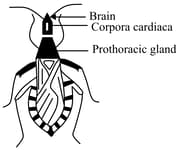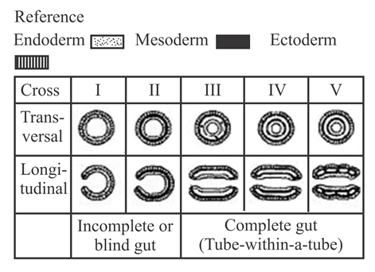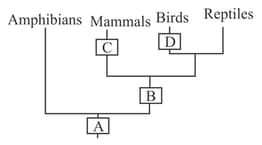Match column I with column II and select the correct option from the given codes.
Column I
Column II
A. Protochordata
(i) Delphinus
B. Limbless amphibia
(ii) Myxine
C. Oviparous mammal
(iii) Ornithorhynchus
D. Aquatic mammal
(iv) Doliolum
E. Jawless vertebrate
(v) Ichthyophis

Important Questions on Animal Kingdom
Refer to the given figures A -D and select the incorrect statement regarding them.

Which of the following are correct?
(i) Sponges: Cellular level of organisation
(ii) Cnidaria: Tissue level of organisation
(iii) Platyhelminthes: Organ level of organisation
(iv) Annelids, Arthropods, Molluscs, Echinoderms and Chordates: Organ system level of organisation
Rhodnius, a blood-sucking bug, shows five instars before it metamorphosis into an adult. It has a long head with the brain located at its tip, and an organ called Corpora Cardiaca (CC). The hormone that ensures the continuum of the juvenile stage is called a juvenile hormone. Behind the head is a pro-thoracic gland, which gets triggered by the Pro-Thoracico-Tropic Hormone (PTTH) to release ecdysone required for moulting into an adult. The following observations were made when the juveniles of this insect were subjected to various conditions:
1. Starved juveniles (any instar) when decapitated remained juveniles and did not moult into adults.

2. Well-fed juveniles (any instar) when decapitated moulted into adults.
3. Starved juveniles (any instar) when partially decapitated to remove the brain cells remained juveniles and did not moult into adults.
4. Well-fed juveniles (any instar) when partially decapitated to get rid of the brain cells didn't moult into adults.
Which of the following conclusions can be drawn from this data?
(i) Ecdysone hormone is produced irrespective of the level of feeding.
(ii) CC is the site of production of juvenile hormone.
(iii) PTTH is produced irrespective of the level of feeding.
(iv) Increase in juvenile hormone is an important trigger for production of PTTH.
(v) Absence of CC alone is a trigger for molting into adult form.
(vi) Well-fed larvae in absence of juvenile hormone can molt into adults.
Observe the following diagrams of invertebrates embryos illustrating the characteristics of the body plan. Reference

Select the correct sequence which corresponds to the Phyla represented with and
Animal classification is depicted below. Mark the correct option.

Match animals given in column with their respective mode of locomotion from column and select the correct option.
| Column_I | Column_II | ||
| W | Ciliary locomotion | I | Earthworm |
| X | Looping movements | II | Nereis |
| Y | Alternate movements of multiple limbs | III | Crab |
| Z | Circular and longitudinal muscles in the body | IV | Planaria |
| V | Amoeba | ||
| VI | Leech | ||
